[Retracted] Multiplicative Topological Properties on Degree Based for Fourth Type of Hex-Derived Networks
Abstract
Chemical graph theory is a subfield of graph theory that uses a molecular graph to describe a chemical compound. When there is at least one connection between the vertices of a graph, it is said to be connected. Topology of graph has been expressed by numerical quantity which is known as topological index. Cheminformatics is a product field that combines chemistry, mathematics, and computer science. The graph plays a key role in modelling and coming up with any chemical arrangement. In this paper, we computed the multiplicative degree-based indices like Randić, Zagreb, Harmonic, augmented Zagreb, atom-bond connectivity, and geometric-arithmetic indices for newly developed fourth type of hex-derived networks and also present the graphical representations of results.
1. Introduction
Graph theory has provided chemists with a number of useful methods, such as topological indices. A molecular graph is often used to represent molecules and molecular compounds. A molecular graph is a graph theory definition of a compound’s molecular formula, the vertices that correspond to the compound’s atoms, and hence the edges that correspond to chemical bonds. Cheminformatics may be a trendy subject that would be a mix of chemistry, arithmetic, and data science. Topological indices, given by graph theory, square measure a vital tool. The topology index could be a quantity associated with a graph that unambiguously characterizes that graph. The chemical graph theory could be a combination of chemistry and graph theory. It is the mathematical chemistry branch that applies the graph hypothesis for modelling chemical structure. A graph will acknowledge a network, a meeting of numbers, a numeric variety, and a polynomial that speaks to the structure of that chart. The vertices and the edges of any chart moreover speak to the topological records. Cheminformatics is a modern scholarly field that brings together the fields of chemistry, mathematics, and information science. It examines the relationships between QSAR and QSPR, which are used to estimate biological activities and chemical compound properties. Wiener is the pioneer of TIs; he developed this theory in 1947, when he was working on the boiling points of Paraffins. Wiener called it a path number but afterwards; it is introduced by Wiener [1]. It is the first distance-based topological index. Topological indices are valuable in QSAR and QSPR studies, as they can alter the chemical structure into numerical values. More than 100 topological descriptors evaluated to get the connection between the atoms. There are a few strategies for evaluating atomic structures, the topological index of which is the most common since it can be derived specifically from atomic structures and measured effectively for a huge number of atoms.
1.1. Method for Drawing HDN4 Networks
Step 1. Let take a benzene network with dimension r.
Step 2. Place benzene graph in each K3 subgraph of hexagonal network.
Step 3. Connect alternating vertices of each benzene graph to every corner of triangle.
Step 4. At the end, the derived result of the graph is called the fourth type of hex-derived network HDN4 (see Figure 1). In this way, we can also construct THDN4 (see Figure 2) and RHDN4 (see Figure 3).
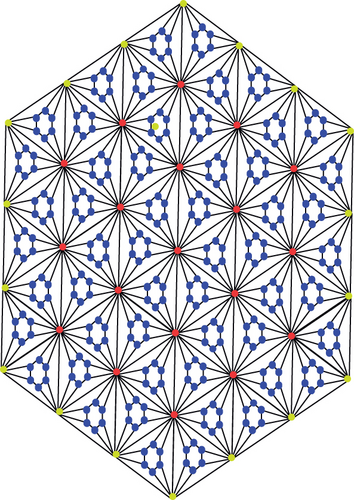
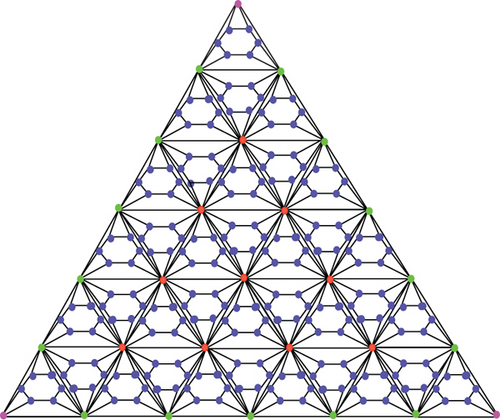
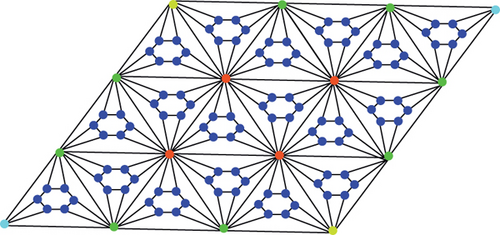
On the newly developed graphs, the degree-based TIs have been calculated in this paper. First of all, Randić index computes on the fourth type of hex-derived network.
2. Main Results
In this research article, we introduced the different kinds of fourth type of hex-derived networks. The degree-based topological indices have been calculated in this research on the above networks. Currently, there is exhaustive study on the topological indices and with different kinds, see [7–9].For the basic definitions about graph theory and notations, see [10, 11].
2.1. Results for Fourth Type of the Hex-Derived Network HDN4(r)
For the first time, we compute the exact result on the above mentioned indices in Section 1 for newly developed graphs in this section.
Theorem 1. Consider the fourth type of hex-derived network HDN4(r), the general form of the Randić index is equal to:
Proof. The Y1≅HDN4(r) is shown in Figure 1, where condition r ≥ 4. Thus, by using equation (1), it follows that
| where | Number of edges | where | Number of edges |
|---|---|---|---|
| (3, 3) | 36r2 − 72r + 36 | (7, 18) | 12m − 18 |
| (3, 7) | 36r − 48 | (18, 18) | 9r2 − 33r + 30 |
| (3, 18) | 36r2 − 108r + 84 | ||
| (7, 7) | 6r − 6 |
Theorem 2. For fourth type of hex-derived network Y1, the first form of the Zagreb index is equal to:
Proof. Let Y1≅HDN4(r) be the hex-derived network. The below is the result of using the Table 1. Equation (2) can be used to calculate the Zagreb index as follows:
By doing some calculations, we get:
The H-index, AZI-index, ABC-index, and GA-index have been computed for the fourth type of hex-derived network Y1.
Theorem 3. Let Y1 be the fourth form of the hex-derived network, then:
- (i)
H(Y1) = (223/14)r2 − (28961/1050)r + 5507/525
- (ii)
AZI(Y1) = (4865917013307/539172272)r2 − (35453987024262256/1230020443767)r + 88794905734397152/3690061331301
- (iii)
ABC(Y1) = 8r2 − 92r + 43
- (iv)
GA(Y1) = 70r2 − 131r + 59
Proof. Using Table 1 and equation (3) to calculate the Harmonic index.
By doing some calculations, we get
By using equation (4) to calculate the augmented Zagreb index is equal to:
By doing some calculations, we get
By using equation (5) to calculate the ABC-index:
By doing some calculations, we get
By using equation (6) to calculate the geometric arithmetic index
By doing some calculations, we get
2.2. Results for Fourth Type of Triangular Hex-Derived Network THDN4(r)
The degree-based TIs have been computed for the fourth form of the triangular hex-derived network in this portion. We calculate general form of Randić index Rγ with γ = {1, −1, 1/2, −1/2}, M1-index, H-index, AZI-index, ABC-index, and GA-index in the coming theorems.
Theorem 4. Consider the THDN4(r), then general form of the Randić index is equal to:
| where | Number of edges | where | Number of edges |
|---|---|---|---|
| (3, 3) | 6r2 − 12r + 6 | (4, 10) | 6 |
| (3, 4) | 6 | (10, 10) | 3(r − 2) |
| (3, 10) | 9(2r − 4) | (10, 18) | 6(m − 3) |
| (3, 18) | 2(3r2 − 15r + 18) | (18, 18) |
|
Theorem 5. The first form of the Zagreb index for fourth type of triangular hex-derived network Y2 is equivalent to:
Proof. Let Y2≅THDN3(r). Using Table 2 and equation (2), the first Zagreb index is equal to
By doing some calculations, we get:
Theorem 6. Let Y2 be the THDN4, then:
- (i)
H(Y2) = (223/84)r2 − (21527/5460)r + 717/455
- (ii)
AZI(Y2) = (1203267/800)r2 − (2816367/400)r + 325590119/36000
- (iii)
ABC(Y2) = 8r2 − 15r + 7
- (iv)
GA(Y2) = 12r2 − 19r + 7
Proof. Using Table 2 to calculate the Harmonic index and using equation (3):
By doing some calculations, we get
Using equation (5) to calculate the augmented Zagreb index.
By doing some calculations, we get
By using equation (6) to calculate the atom bond connectivity index
By doing some calculations, we get
By using equation (7) to calculate the geometric arithmetic index:
By doing some calculations, we get
2.3. Result for Fourth Type of Rectangular Hex-Derived Network RHDN4(r, s)
Some topological indices which based on the degree of the RHDN4(r, s) with condition r = s have been computed in this portion. We evaluate the general form Randić index Rγ(RHDN4(r)) for the γ = {1, −1, 1/2, −1/2}, M1-index, H-index, AZI-index, ABC-index, and GA-index in the forward theorems of RHDN4(r, s).
Theorem 7. For the fourth type of rectangular hex-derived network RHDN4(r), the general Randić index is equal to
Proof. Let Y3≅RHDN4(r) be seen in Figure 3, with condition r = s ≥ 4. The edge partition as seen in the table is as follows:
For γ = 1, the general form of the Randić index Rγ(Y3) can be calculated as follows:
| where | Number of edges | where | Number of edges |
|---|---|---|---|
| (3, 3) | 12r2 − 24r + 12 | (7, 10) | 4 |
| (3, 4) | 4 | (7, 18) | 2 |
| (3, 7) | 8 | (10, 10) | 2(2r − 5) |
| (3, 10) | 6(4r − 8) | (10, 18) | 4(2r − 5) |
| (3, 18) | 6(2r2 − 8r + 8) | (18, 18) | 3r2 − 16r + 21 |
| (4, 10) | 4 |
Theorem 8. The first Zagreb index for the RHDN4(r) is equivalent to
Proof. Let Y3≅RHDN4(r). Using Table 3 and equation (2) to calculate the Zagreb index:
By doing some calculations, we get
Now, we calculate the H-index, AZI-index, ABC-index, and GA-index for RHDN4(r).
Theorem 9. Let Y3 be the fourth type of rectangular hex-derived network, then:
- (i)
H(Y3) = (439/84)r2 − (4886/585)r + 1525241/464100
- (ii)
AZI(Y3) = (240663/80)r2 − (2278779/200)r + 268079839/24000
- (iii)
ABC(Y3) = 2(8r − 7)(r − 1)
- (iv)
GA(Y3) = 23r2 − 42r + 18
Proof. Using Table 3 and equation (3) to calculate the Harmonic index:
By doing some calculations, we get
Using equation (4) to calculate the augmented Zagreb index:
By doing some calculations, we get
Using equation (5) to calculate the atom bond connectivity index:
By doing some calculations, we get
Using equation (6) to geometric arithmetic index:
By doing some calculations, we get
For comparison through graphs, the comparison of the different topological indices for the HDN4, THDN4, and RHDN4, a newly developed fourth type of hex-derived networks has been evaluated for the different values. The graphical representation shows the correctness of the results as shown in Figures 4–9.
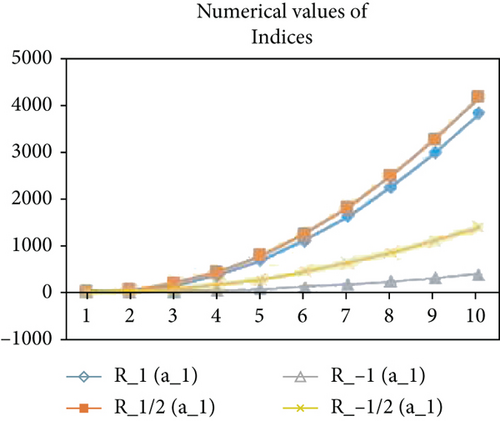
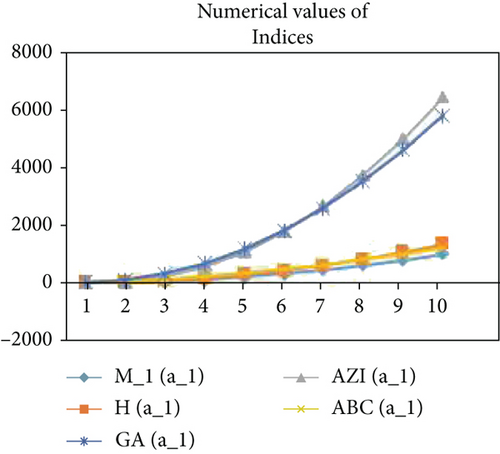
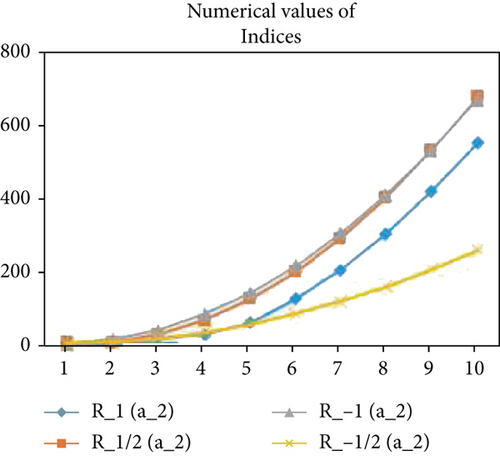
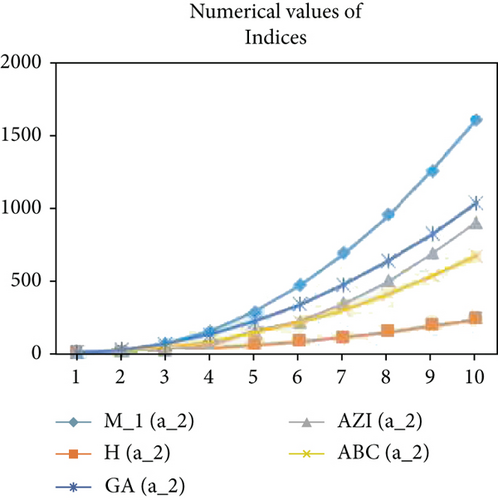
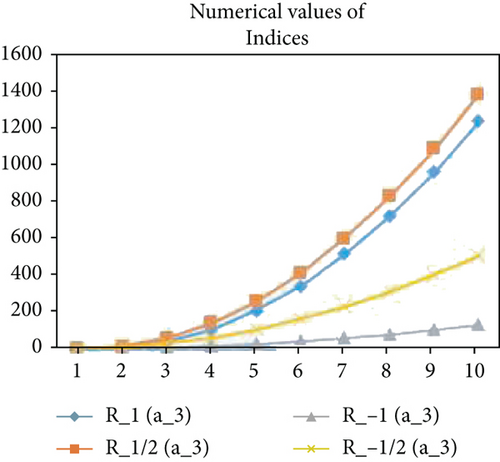
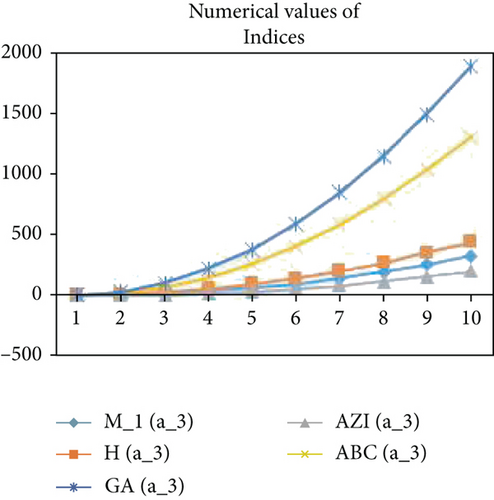
3. Conclusion
In this paper, certain degree-based topological indices, namely, the Randić, Zagreb, Harmonic, augmented Zagreb, atom-bond connectivity, and geometric-arithmetic indices for the HDN4, THDN4, and RHDN4 networks, were studied for the first time, and analytical closed formulas for these networks were determined that will help the people working in network science to understand the underlying topologies of these networks. In future, we are interested in designing some new architectures/networks and then studying their topological indices, which will be quite helpful in understanding their underlying topologies.
Conflicts of Interest
The authors declare that they have no conflicts of interest.
Open Research
Data Availability
No data were used to support this study.




